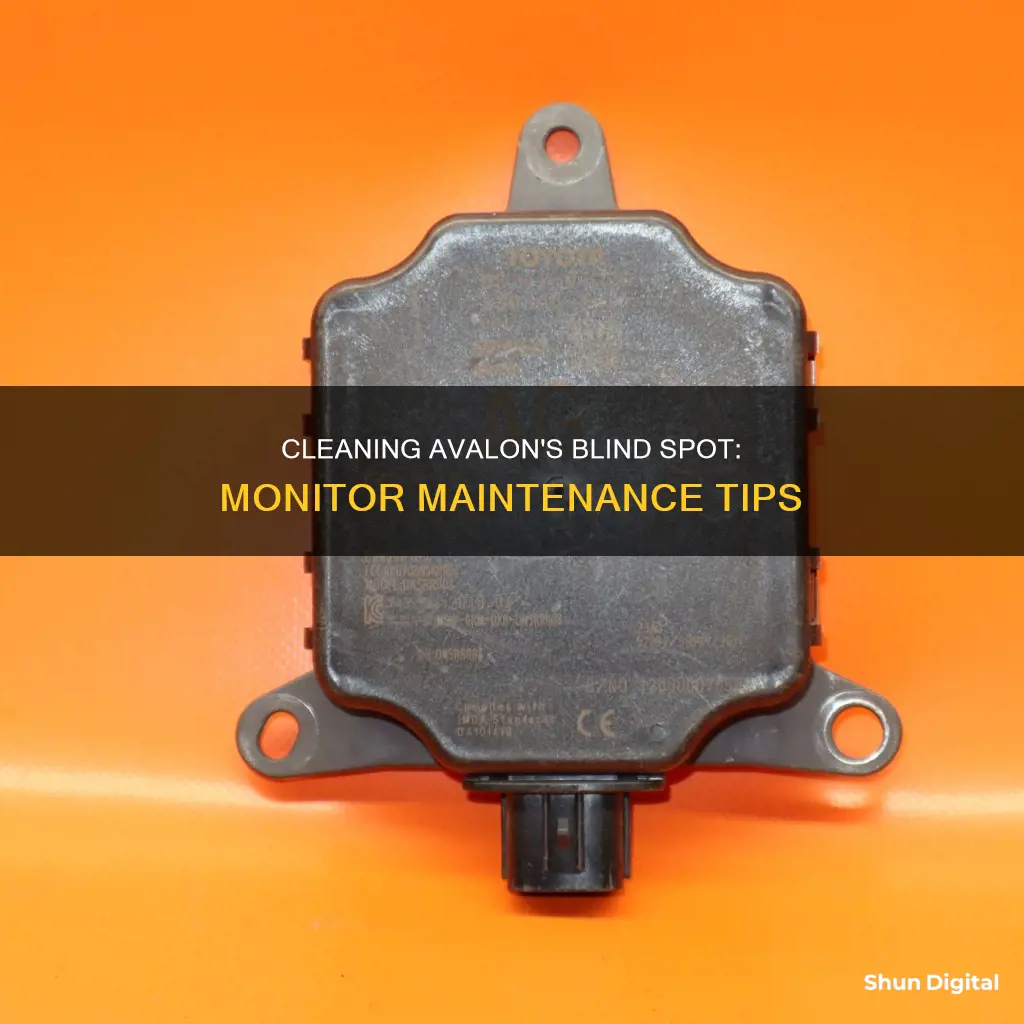
Blind-spot monitoring (BSM) is a safety feature that helps prevent accidents by alerting drivers of potential hazards in their blind spots. It is especially useful for larger vehicles, where blind spots tend to be bigger, and for drivers who haven't mastered the art of setting their side mirrors correctly. While BSM was once a luxury feature, it is now available in various forms, including as a factory-installed option or as an aftermarket addition. This article will provide a step-by-step guide to cleaning the blind spot monitors on an Avalon, ensuring they remain free of dust and grime for optimal performance.
| Characteristics | Values |
|---|---|
| Blind spot monitor error | The error message will often return even if you turn off the BSM manually |
| Temporary fix | Turn off the vehicle and the ignition for a few seconds and then turn it back on |
| Permanent fix | Clean any dirt or debris away from the sensors and turn off the vehicle ignition for a few seconds to re-calibrate the sensors |
| Sensor location | Two BSM sensors are located on the inside left and right of the rear bumper |
| Sensor issues | Sensors are prone to getting covered with dust, dirt, mud, spider webs, lawn debris, and other obstructions |
| Repair procedure | Toyota Class 301 provides a repair procedure for the Blind Spot Monitor Sensor (BSMS) bracket |
| Calibration | Calibration cloth is placed behind the vehicle and aligned with a measuring tape at a 90-degree angle |
What You'll Learn

Cleaning dirt and debris from sensors
Blind Spot Monitor Sensors (BSMS) are prone to getting covered in dirt and debris, which can cause them to malfunction and display an error message. Cleaning any dirt or debris away from the sensors can restore them to proper operation.
To clean dirt and debris from the sensors, first locate them on your vehicle. On most Toyota vehicles, there are two BSM sensors located on the inside left and right of the rear bumper. Once you have located the sensors, simply clean any mud or other debris away from the area. You can use a cleaning cloth and rubbing alcohol to clean the sensors effectively. Ensure that you clean the calibrating positions in the inner rear bumper as well.
After cleaning the sensors, turn off the vehicle ignition for a few seconds and then turn it back on to recalibrate the sensors. This should restore the blind spot monitor to proper operation and eliminate the error message.
It is important to note that the process for repairing and recalibrating the BSMS may vary slightly depending on the specific vehicle model. For example, the Toyota Class 301 provides detailed steps for repairing the BSMS bracket to OEM specifications, which includes measuring and comparing specific values.
Additionally, some vehicles may have cameras inserted into the side mirrors that function as part of the blind spot monitoring system. These cameras should also be kept clean and free of debris to ensure proper functioning.
Finding Apple Monitor Versions: A Step-by-Step Guide
You may want to see also

Using cleaning cloth and rubbing alcohol
To clean the blind spot monitors on an Avalon, you can use a cleaning cloth and rubbing alcohol. Here is a step-by-step guide:
Firstly, it is important to prepare your workspace and gather the necessary materials. In this case, you will need a cleaning cloth, preferably a microfiber cloth, and some rubbing alcohol. Microfiber cloths are ideal because they are extremely soft, effective at attracting dust and absorbing oils, and gentle on the screen.
Before you begin cleaning, make sure to turn off and unplug your monitor to avoid any electrical issues during the cleaning process. This is a crucial step to ensure safety.
Now, you can start by pouring a small amount of the rubbing alcohol onto your microfiber cloth. Avoid pouring too much, as excess liquid can seep into the edges of the monitor and cause potential damage.
Gently wipe the blind spot monitors with the cloth, using small circular motions. Ensure that the cloth is not overly wet, and be careful not to apply direct pressure to the screen. You want the cloth to glide gently over the surface. This technique will help remove any dirt, dust, or smudges that may be present.
If you encounter stubborn marks or stains, you can dampen the cloth slightly more with the rubbing alcohol. However, always avoid spraying or pouring liquids directly onto the screen, as this can increase the risk of liquid seeping into sensitive areas and causing damage.
Finally, let the monitor air-dry completely before turning it back on. This process will help ensure that your blind spot monitors on your Avalon are clean and streak-free, providing you with optimal viewing.
DDC CI Option: What Does ASUS Monitor Feature Offer?
You may want to see also

Placing magnets on the outside of the vehicle
To install an aftermarket blind spot monitor, you will need to place two magnets on the outside of your vehicle. This process will require some tools and preparation, so it is important to follow the steps carefully.
First, you will need to gather your tools and materials. For this step of the installation process, you will need the calibration cloth from your system, a measuring tape, a level, a marker, two magnets, and adhesive. Once you have these items, you can begin the process of placing the magnets on the outside of your vehicle.
Start by placing the measuring tape parallel to your vehicle's wheels. Then, take the calibration cloth and place it behind the vehicle, aligning it with the measuring tape at a 90-degree angle. This will ensure that your sensors are properly calibrated.
Next, take the level and stand it vertically against the vehicle. The level should also align with the calibration cloth. Use the marker to draw a straight line on the vehicle's rear bumper, following the edge of the level. This line will guide the placement of your magnets.
Now, you can place the magnets on the outside of the vehicle. Take one of the two magnets and place it on the line you drew on the rear bumper. The magnet should be placed at a 20-degree angle from the bumper. You may need to adjust the exact placement to ensure that the magnets attract each other.
Once you are satisfied with the placement of the first magnet, mark the spot with the marker. This will indicate where the corresponding magnet will be placed on the inside of the bumper. Then, apply adhesive to the magnet and stick it securely in place on the outside of the bumper.
Repeat this process for the second magnet, placing it in the corresponding position on the other side of the vehicle. Ensure that the magnets are securely attached and properly aligned before moving on to the next step of the installation process.
By carefully placing the magnets on the outside of your vehicle, you will ensure the proper functioning of your blind spot monitoring system. Remember to refer to the specific instructions provided with your aftermarket kit for a more detailed guide.
Connecting Your MacBook to Monitors: A Comprehensive Guide
You may want to see also

Applying adhesive to the sensors
When applying adhesive to the sensors, ensure you have cleaned the calibration points with a cloth and rubbing alcohol. This will ensure the sensors stick effectively. You will also need to have magnets placed on the inside and outside of the bumper, so the sensors can be stuck at the correct angle.
The adhesive should be applied directly to the sensors, following the instructions on the adhesive packaging for the correct amount to use. It is important to apply enough adhesive to ensure the sensors are secure, but not so much that it leaks out and damages the sensors or the vehicle.
Once the adhesive is applied, carefully stick the sensors onto the marked spots inside the bumper. Hold them in place for a few seconds to ensure they are properly adhered.
After the sensors are in place, you can mount the LED indicators inside the cabin of the vehicle. These should be placed somewhere easily visible, without obstructing the driver's view of the road. Most kits will include recommendations for placement.
Finally, adjust the volume of the indicators to ensure they are at a suitable level. You don't want to be startled when the system activates, so test it out and adjust as needed.
Locating the Serial Number on a Sceptre C27 Monitor
You may want to see also

Mounting LED indicators in the cabin
To clean the blind spot monitor sensors on your Toyota Avalon, you'll need to locate the sensors themselves. On most Toyota vehicles, there are two BSM sensors located on the inside left and right of the rear bumper.
Now, for mounting LED indicators in the cabin:
Firstly, ensure you have the necessary tools and equipment ready. Gather your aftermarket blind spot monitor kit, which should include the LED indicators, as well as basic tools like a marker, cleaning cloth, and adhesive. It is also recommended to have a calibration cloth and a level tool for accurate placement.
Once you have the required items, you can begin the process of mounting the LED indicators. These indicators are crucial as they provide visual alerts within the cabin, working in tandem with the sensors to notify you of potential hazards.
The placement of the LED indicators is important. You should aim to position them in a location that is easily visible without obstructing your view of the road. Most aftermarket kits will provide recommendations for placement, so refer to the instructions provided with your kit. It is important to consider the driver's seating position and eye level when deciding on the final location for the indicators. Ensure they are securely mounted and angled towards the driver for optimal visibility.
After mounting the LED indicators, you will need to adjust the volume of the accompanying alarm. Test the system to ensure the volume is set to an appropriate level that effectively alerts you without being overly startling. A too-loud alarm can be distracting and unpleasant, so adjust accordingly.
If you have any questions or encounter difficulties during the installation process, don't hesitate to reach out to a professional service center for assistance. They can provide guidance and ensure a proper installation.
Remember, while a blind spot monitoring system is a valuable addition to your vehicle, it should not replace your regular use of mirrors and checking of blind spots. Stay cautious and use this technology as an additional safety feature to enhance your driving experience.
Monitoring Hotspot Usage: A Guide for Samsung Note 8 Users
You may want to see also
Frequently asked questions
The sensors are located on the inside left and right of the rear bumper. They can be cleaned by simply wiping away any dirt or debris with a cloth.
A microfibre cloth is recommended to avoid scratching the sensors.
You can use a mild detergent or rubbing alcohol to help remove stubborn dirt or debris. Be sure to apply the liquid to the cloth first, rather than directly onto the sensors.
It is recommended to clean the sensors regularly, especially if you notice any dirt or debris buildup. A good rule of thumb is to clean them whenever you wash your car.
Cleaning the sensors can help ensure that they are functioning properly and accurately detecting vehicles or objects in your blind spot, thus improving your safety while driving.







